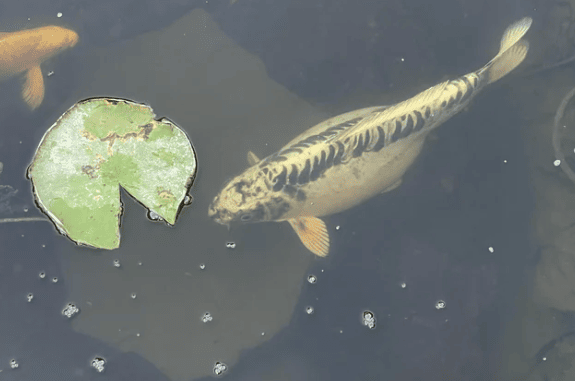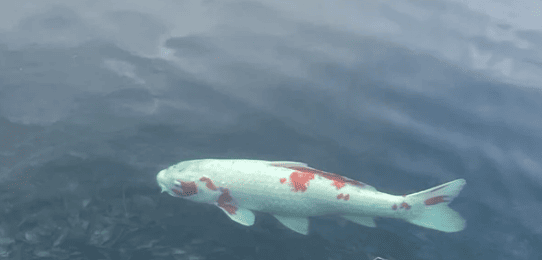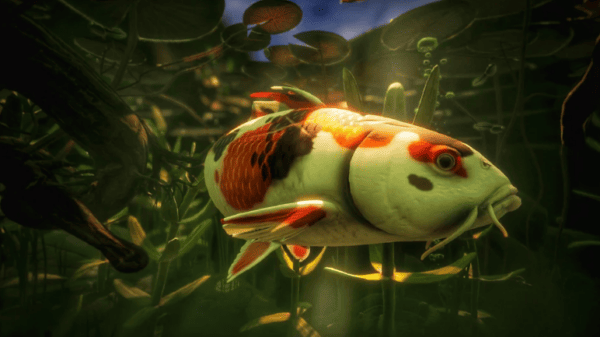Descendants of common carp found in various regions of Asia and Europe, the Koi fish are the result of centuries of human effort and selective breeding. While they’re often found in wild habitats, those mainly are released or escaped individuals. They may also interbreed with other carp in the wild.

In your tank or pond, you may encounter the male fish bumping the female or the female seeming a bit plumper. While these are typical mating behavior, they don’t guarantee “pregnancy.”
In this article, we’ll go through the signs of Koi Fish pregnancy and prepare a care guide for eggs and fry.
Table of Contents
Koi Reproduction Process
Pregnancy is not the correct term to associate Koi Fish spawning with. As they aren’t livebearers, the female Koi Fish hold and release unfertilized eggs upon maturity. The males externally fertilize the eggs.
Koi females go through a year-long cycle to develop their eggs. Therefore, spawning occurs annually around spring when the weather gradually begins to warm.
The males sexually mature at the age of 3 to 5 years, while the females can lay eggs at four to six years old. They can reproduce for six to seven years afterward. Considering that Koi Fish can live for 30-40 years in captivity, this seems pretty short.
During the spawning season, you may notice your female Koi bloated and appear pregnant. However, don’t expect them to give birth to live baby fish without pairing them with a male koi and providing adequate breeding parameters.

You can stop the mating process by separating the female into a different tank, where there are no males to agitate them. Without the presence of a male, the female Koi won’t spawn the eggs and would eventually reabsorb the protein.
Koi Fish also exhibit sexual dimorphism. While it’s much easier to determine their sexes after maturity and are over 12 inches, it can be done with a varying level of accuracy before that. The most prominent way to tell a male from a female Koi is their smaller, more pointed fins. They also are more colorful than the females.
Females have larger, rounded fins, with a “blimpy” body shape, and are built wider. Females also tend to grow larger than males. This trend of females growing larger is thought to be the result of years of selective breeding with larger females and smaller males.
Is My Koi Fish Pregnant?
Whether your objective is to facilitate the spawning or terminate it, it’s worth knowing whether your koi is pregnant or not. While bloating is a prominent sign, it often deceives the most experienced breeders.
In the case of Koi Fish, considering they’re voracious feeders, it could simply be a case of overeating. Or, they could have developed a gastrointestinal issue that needs to be cared for.
Moreover, as Koi Fish spawn annually, they produce large amounts of eggs, sometimes in the thousands, in a single breeding season. While most of them get cannibalized by other fish, you need to offer larger spawning tanks for them to sustain and give proper care. Therefore, being informed about the situation is critical.
Here are the signs that your Koi Fish is pregnant:
Physical Signs of Koi Pregnancy
A few fundamental physical signs often indicate approaching spawning conditions in females. They are:
- Age and size
Female Koi Fish reaches sexual maturity at 3 to 5 years of age. Before that, it is almost impossible for them to develop eggs or spawn. By this time, they grow around 10 inches long.
Females, younger or shorter than that, are unlikely to produce eggs. Your koi probably had a feeding frenzy. Moreover, if it’s not springtime, they may just the plump and not pregnant.
Also, It takes a full year for the koi eggs to mature. Don’t be alarmed if it hasn’t been long before your female koi was spawning.
- Enlarged abdomen
A one-sided bloated abdomen is the most tell-tale sign that your Koi Fish may be pregnant. An enlarged abdomen, paired with other behavioral signs, indicates that you need to either introduce a male to your tank or terminate the process by relocating the female.
However, a bloated abdomen doesn’t always ensure pregnancy. As discussed, it may also be an indication of underlying parasitic illness or overfeeding. Rely on the behavioral cues of the female to solidify the argument before raising their stress levels.
- Fuller body
In addition to the abdominal region, the whole body of your female koi may appear rounder than usual if they’ve developed eggs. While it may be difficult to notice a slightly fuller body, it can be used to verify other physical signs.
- Elevated vent
The vent is a small opening located just above the anal fin. While its more common purpose is waste elimination, it also serves as the reproductive function in fish. Both male and female koi have vents.
During the breeding season, your female koi may develop a more profound and elevated vent to indicate egg maturity and spawning potential. However, as with other signs, verify it with other physical and behavioral cues to confirm.
Behavioral Signs of Koi Pregnancy
More than the obvious physical changes, behavioral indicators are more promising in terms of determining the spawning conditions. As behavioral signs are observable in both sexes, it’s more consistent and prominent.
- Male Koi clinginess
Female Koi releases pheromones when the eggs are almost ready. This allures their male counterparts, and they respond by approaching her and staying close. The males may demonstrate typical courtship behavior during this time and try to push and prod her around the tank or pond.
- Nest cleaning
The females often choose a spawning spot that they clean and create a depression in the substrate. However, the intent of the female koi is much more important than the structure or the form of the substrate. This behavior is seen prior to the eggs maturing.
- Touching the vegetation
The female often touches the vegetation and brushes their body against the structure to signal her readiness.
- Increasingly aggressive
Just before the spawning event, when the females lay eggs, the males continue to aggressively head-butt and bump her. They become so aggressive that the female often attempts to jump out of the water. However, they lose interest right after releasing their milt and fertilization.
Best Setup for Koi Breeding

Koi are very picky breeders. As they are limited by their short reproductive years and lack of care toward their newly hatched, they only choose to breed when the conditions are optimum.
We’ll go through the ideal tank setup and water parameters in a bit, but before that, let’s understand the spawning process and requirements.
Spawning
The spawning event starts the morning after the male koi performs peak courtship behavior. Usually, the female starts laying her eggs in the early morning and concludes the process by noon. The males follow the spawning female and release their milt onto the eggs.
If you have a koi pond, it may not be possible to separate males and females 1:1. Therefore, the whole breeding process becomes pretty exhausting for all the parties involved. You may, for a while, see reduced activity in the pond after the event.
Typically, foam accumulation near the filters and aerators is a sure sign of koi breeding. The water may turn cloudy and smell fishy for a few days. If there are multiple females in the pond, it may even take up to 3 days to finish the breeding process.
During this time, it’s best to restrict your koi diet to the bare minimum. As they would be preoccupied, they may lose interest in feeding. Do check for water quality for excessive nutrients and expelled materials frequently.
If there are multiple spawning pairs in the pond, consider doing frequent partial water changes without disrupting the process.
Tank Setup
Koi Fish go through a form of winter hibernation, called torpor, which consists of minimum movement and physiological activity. They emerge from hibernation hungry and eager to mate.
The tank size and dimensions are of primary importance when breeding koi. Ensure your tank is at least 4 X 4 X 2 feet in dimension and holds 200 gallons of water. It should also be supported with filtration, heating, and pumping systems. Spawning bush and grass are also essential for freshly released eggs.
Maintain the water parameters mentioned later and be careful with the temperature, as very low temperatures can terminate the breeding process.
When the spawning event starts, and the female is ready to lay eggs, replace the filtration systems with aerators to ensure the survival of the eggs. Before breeding starts, it’s recommended to clean and cycle your pond and tank.
Remove any other fish that aren’t to participate in the spawning event, even other Koi Fish. Also, remove any decorations or sharp objects that can hurt the koi. As they would be violently chasing and bumping into each other, covering the pond with netting is advised.
The breeding pairs also are introduced in this stage. Choose one or two males for each female koi. You may introduce three males, but not more than that. It puts undue stress on the female. The other males may not be interested to breed and may put their focus solely on eating the eggs.
Moreover, only consider koi that appear healthy and are at least 10 inches in length.
Water Parameters
Let’s discuss the critical water parameters required for koi breeding.
| Parameter Name | Desired Levels | How to achieve |
| Water temperature | 68 – 75 F | Use a heater to increase temperature.Increase evaporation to reduce water temperature. |
| pH | 7.0 – 8.0 | Commercial pH solutions.Water changes. |
| Hardness | GH: 100 – 300 ppmKH: 100 – 200 ppm | Use commercial solutions. Add baking soda for alkalinity (KH). Ass minerals for general hardness (GH). |
| Dissolved oxygen | 6 mg/L | Use quality air pumps. |
| Ammonia, nitrite, copper, chlorine | Zero (undetectable levels) | Perform regular water changes. Employ biofiltration. Keep the pond clean. |
| Nitrate | Below 40 ppm | Partial water changes. |
Frequently check the water parameters throughout the breeding season and beyond for sustainable koi keeping.
Post-Spawning
After successful egg release, males start to lose interest in the females. This is when both of them come back to feed on the majority of the eggs in the tank. Typically, only 10% of these eggs survive the frenzy, and less than that successfully fertilize.
While professional breeders prefer to separately care for the eggs after spawning, you may choose to leave them in the pond.
At this point, resume feeding your koi fish normally at a regular frequency. The males recover pretty quickly after the event, while the females may take a bit longer to resume their regular activities. Keep a close eye on the participants to note unusual behavior and activity.
Thoroughly clean the submerged equipment, including the filter, pond gear, and pumps to remove any gathered eggs. If left unchecked, the eggs may rot and prove detrimental to water quality. Consider doing frequent testing and water changes after the spawning event.
Timeline and Care for Eggs and Fry
| Timeline | Observations and Care |
| Day 1 | Fertilized eggs are usually clear and opaque in color. Koi eggs are around 2mm in diameter and stuck to any surface that the females lay them on. |
| Day 2 | You can observe the development of eyes inside the egg during day 2. Keep the water warm. |
| Day 3-4 | Usually juvenile koi hatch around days 3 and 4. They are about 7mm in length and feed from their egg sack for the first few days. |
| Day 9 | They’ve now grown enough to feed on infusoria and other microbes found in the tank. You can introduce liquid food to their diet now. |
| Day 11 | These fry can eat daphnia and other small live food. Introduce them to ground flake foods. |
| Day 29 | They’ve developed their initial colors and can now be transferred to a larger tank with other smaller fish. |
How to Prevent Koi Spawning
Your intentions don’t matter when you choose to keep both sexes of koi fish together in a healthy pond. They, inevitably, will spawn and crowd the tank, even if you aren’t willing to care for more fish.
However, there are a few simple strategies that can be implemented to prevent or terminate the spawning event.
- Maintaining single-sex pond
Most ornamental keepers, who aren’t interested in breeding, maintain single-sex koi ponds to prevent pregnancy and spawning. Koi are pretty peaceful fish, and males can co-exist together without any issues.
- Regulating local weather conditions
You can try to prevent koi breeding by tricking them into thinking it still isn’t the time. Keep the water temperature low throughout the springtime and reduce daylight time by shading the pond. However, this method, if not done correctly, often refuses to generate any significant outcome on koi spawning events.
- Separation of males and females
If all other methods fail, separate the males and females once you observe courtship behavior. Remove the males or females to a different tank when you begin to spot the enlarged abdomen of females and the excitement of males.
The Bottom Line
Koi pregnancy is an annual event and usually concludes with females laying eggs and males fertilizing them. If not regulated, spawning can bring young koi lives in the pond, who in a few years, would compete for food and space in the same crowded pond. Hopefully, this article was able to give you the necessary information on how to facilitate or terminate the spawning process.
